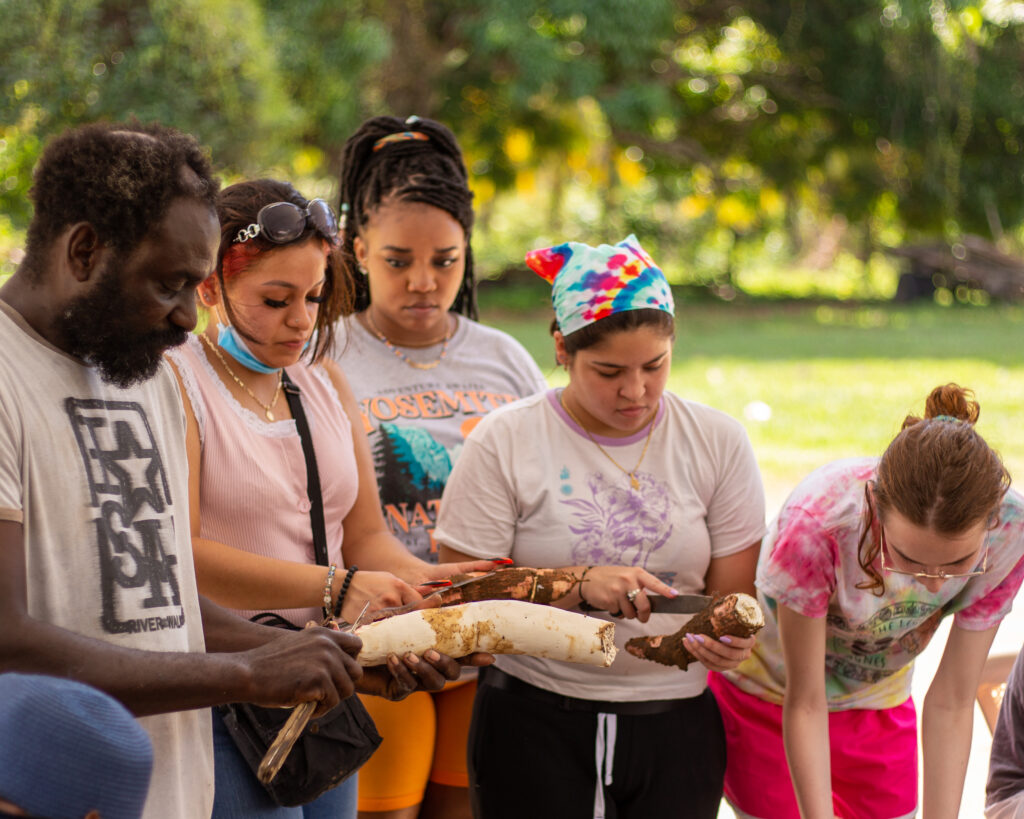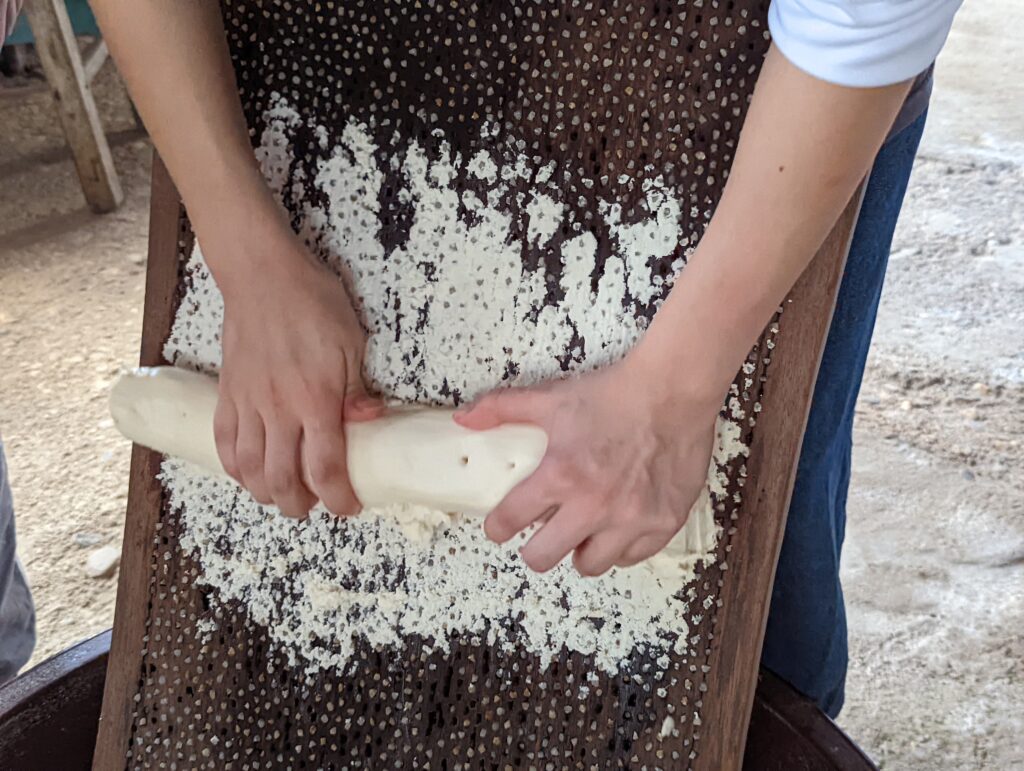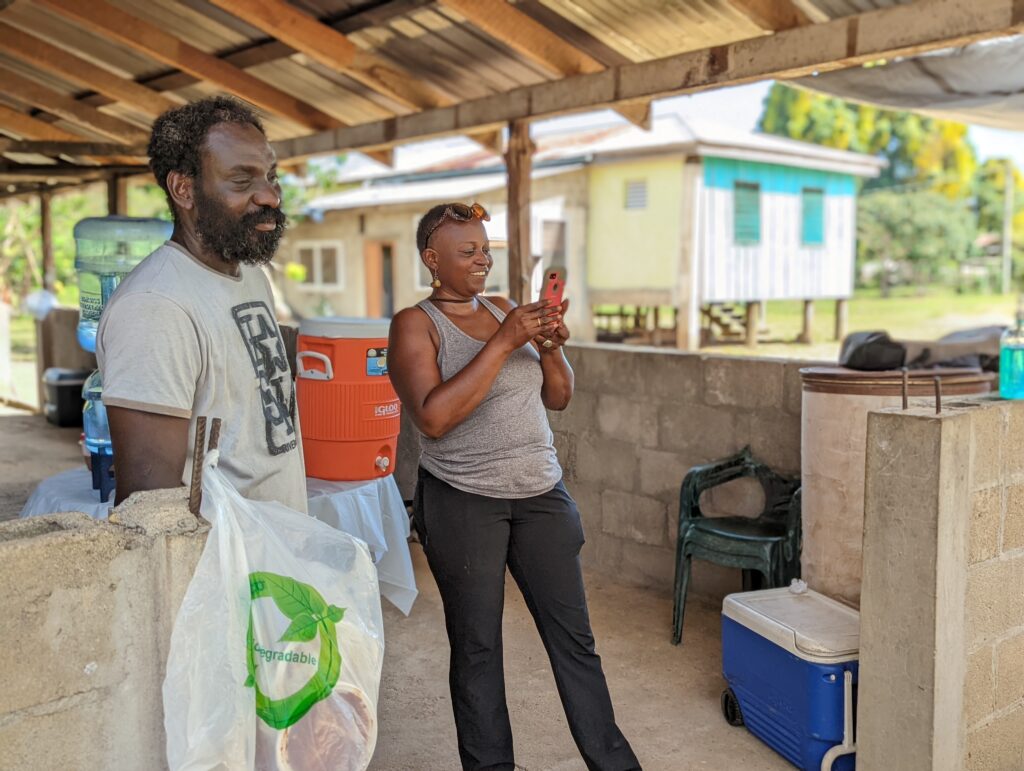By James Diedrick
Posted April 9, 2022
Photos this page © by James Diedrick
Sabal’s Cassava Farm is located at mile three on the Hummingbird Highway, right outside of Dangriga Town, the largest Garifuna community in Belize. This family-owned business has been operating since 1987 and produces 32 products from cassava, including bread, starch, juice (aka “sahou,” made of cassava, coconut milk, cinnamon and sugar), and ginger biscuits . Our Global Journeys Belize class visited the farm on March 7, 2022, and did the hard but rewarding work of turning cassava roots into flatbread. The Garifuna word for cassava is “ereba”; in other countries it is known as yucca.
The farm produces 32 products made from the white cassava, and exports them all over Belize.
Cyril Sabal junior, talked with us about his farm, founded by his father.

Our students went into the white casava fields, wielded machetes, and harvested cassava roots. Then back at the center they peeled the tubers, washed, and grated them. It took hours. But it was good, healthy labor.

One of the staff at the farm, Jeneve (form of Jennifer); oversaw our casava production today.
The day before this visit, our group spent the day at the Palmento Grove Eco-Cultural & Fishing Institute, where we learned from Director Uwahnie Martinez that the cassava played a key role in helping the ancestors of the present-day Garifuna (known in the Caribbean as “Black Caribs”) resist French and British colonizers on St. Vincent Island for decades before being exiled to Central America. (“Black Caribs,” as Ms. Martinez explained, were the result of Africans arriving on the island after escaping slave ships and mixing with Caribs and Arawaks who originally came to the islands from South America.).

She explained that after the French failed to defeat the Black Caribs on they island, they decided “if we can’t beat them, we will join them,” and entered into trading agreements with them. As a result, when the British came to the island seeking control, they met resistance from the combined forces of French and Black Caribs. The British thought they could prevail by destroying the food of the Black Caribs, but the cassava and other root crops stymied them. As Ms. Martinez explained,
They couldn’t win . . . before because they didn’t know about our food. They would often go and destroy our food, but our food were tubers, sweet potato, yam, . . . cassava . . . . So while they would often destroy the top of the food plant, the food would remain on the bottom . . So they would often wonder “hey, why are these guys still alive, we destroyed their food.” But they weren’t destroying our food, they were just destroying our plants. . . . Our food remained at the bottom So we were still able to make our cassava bread in the rain forest. Our food . . . just needs very simple preparation.
She added that the only reason the British finally defeated the Black Caribs (in 1795) was because they brought in African slaves to do their fighting for them, and the Africans knew how to destroy their enemy’s food sources–by digging underground. This defeat is what led the British to exile the Garifuna to the Bay islands of Honduras, and to their eventual dispersion to other parts of Central America, including Guatemala and Belize.
This history helped us recognize that the cassava is much more than a staple of the Garifuna diet–it embodies the resourcefulness, resistance and resiliency of an entire ethnic group.
But can the cassava and cassava production survive and thrive in the 21st century?
According to a 2019 report from the Food and Agriculture Organization of the United Nations, cassava in the Caribbean region holds promise for greater cultivation and production, but its future is uncertain.
The report notes that “cassava is mainly produced in the southern and central part of the country. The Garinagu people (commonly called Garifuna people) consume cassava in fresh and processed forms (chips and baked products). Presently, the bulk of the production (340 MT, equivalent to ≈60% of the national production) comes from the southern part of the country.” The report also notes that cassava production has been in decline for over 10 years, down from 5760 metric tons in 2002 to only 421 in 2012″ (p. 46). In a section titled “The Way Forward,” the report makes the following recommendations, specifically addressed to Belize’s Ministry of Natural Resources and Agriculture (MNRA):
- The feasibility study of cassava production in Belize needs to be updated, to determine economic viability and potential social impact.
- The MNRA should include cassava in the research and demonstration activities, as a strategy to promote crop diversification and reduction of food import bill.
- The MNRA should request technical experiences from national/regional partners in areas related to post-harvest technologies, soil and crop management, marketing and value-added.
- The MNRA, in collaboration with relevant agencies, should develop various technology packages for cassava: fresh consumption, industrial types (processing) and feed use.
- Government support is necessary – this could be in the form of incentives and programs for interested producers and processors.
- The MNRA should lead the process by providing technical guidance to farmers in selection of adequate varieties, source appropriate processing equipment and seek and consolidate alternative, more profitable markets.
Given Americans’ love of chips, perhaps one profitable market lies to the north, though currently Sabal’s Farm supplies the Belize market exclusively.
We can expect to see more cassava chips on store shelves in the future–especially since making cassava chips requires less oil than potato chips, and the chips themselves contain fewer calories, fat and sodium than potato and corn chips. In fact, I just started buying these cassava chips at my local Costco:

But how many American consumers will understand the anti-colonial power and importance of the humble cassava root?